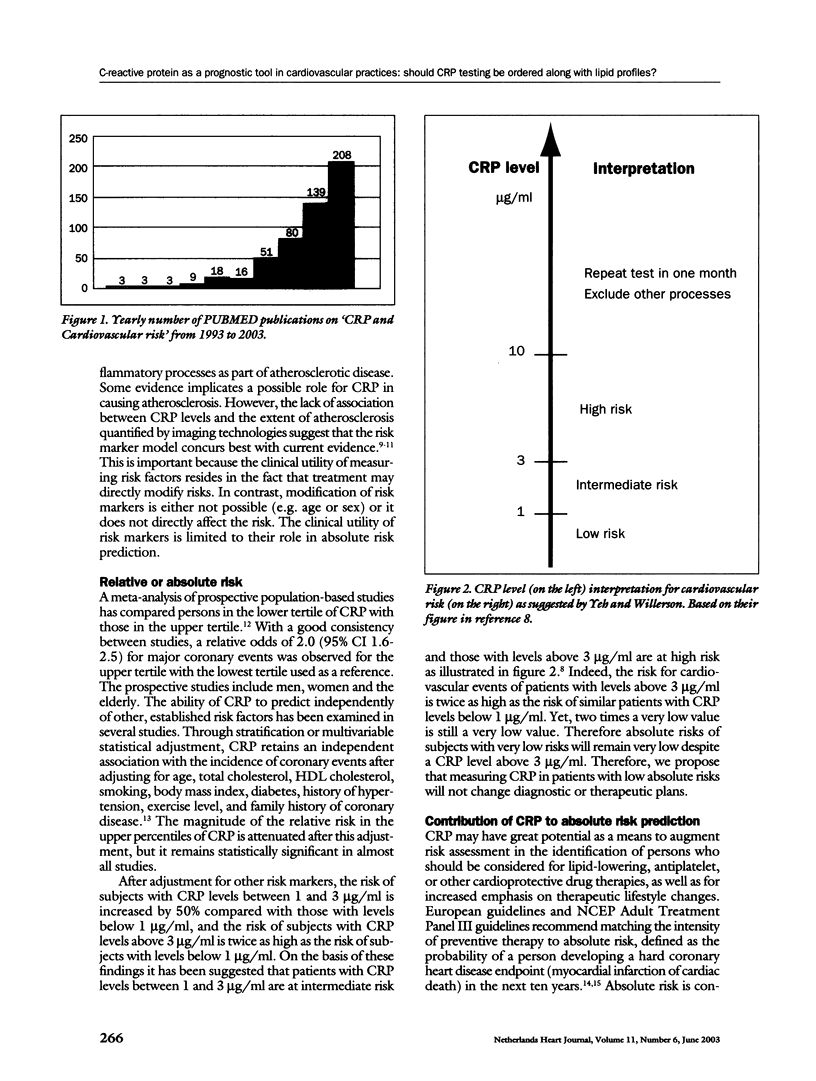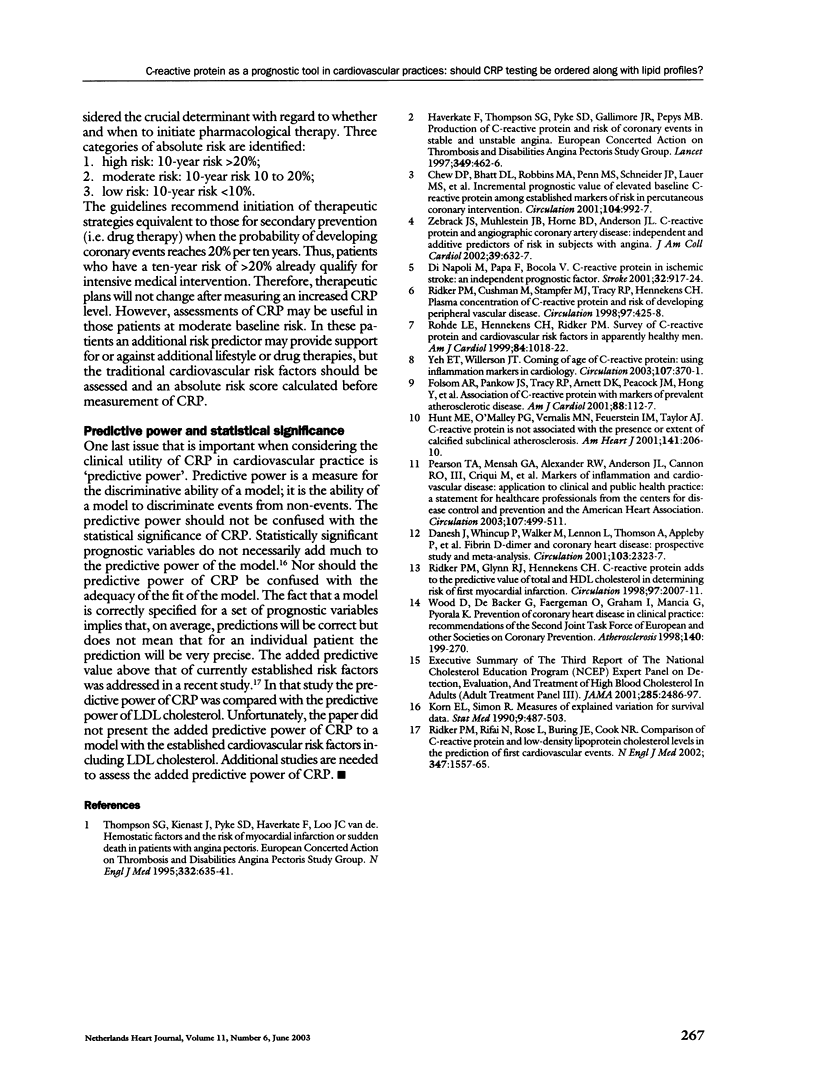Abstract
CRP has a graded, dose-response relationship to the occurrence of clinical cardiovascular events that remains after adjustment for other risk factors, with moderately strong associations between the lower and upper tertiles (RR≈2). It may have clinical utility in improving the estimation of absolute risks of patients with a calculated ten-year risk between 10 and 20%. Individuals at low risk (<10% per 10 years) will be unlikely to have a high risk identified through CRP testing. Additional prospective studies or new statistical analysis of previous studies are needed to establish the added predictive value of CRP above that of currently established risk factors. Thus, currently available evidence suggests that CRP testing should not be ordered along with lipid profiles.
Keywords: C-reactive protein, predictive value, cardiovascular events
Full text
PDF


Images in this article
Selected References
These references are in PubMed. This may not be the complete list of references from this article.
- Chew D. P., Bhatt D. L., Robbins M. A., Penn M. S., Schneider J. P., Lauer M. S., Topol E. J., Ellis S. G. Incremental prognostic value of elevated baseline C-reactive protein among established markers of risk in percutaneous coronary intervention. Circulation. 2001 Aug 28;104(9):992–997. doi: 10.1161/hc3401.095074. [DOI] [PubMed] [Google Scholar]
- Danesh J., Whincup P., Walker M., Lennon L., Thomson A., Appleby P., Rumley A., Lowe G. D. Fibrin D-dimer and coronary heart disease: prospective study and meta-analysis. Circulation. 2001 May 15;103(19):2323–2327. doi: 10.1161/01.cir.103.19.2323. [DOI] [PubMed] [Google Scholar]
- Di Napoli M., Papa F., Bocola V. C-reactive protein in ischemic stroke: an independent prognostic factor. Stroke. 2001 Apr;32(4):917–924. doi: 10.1161/01.str.32.4.917. [DOI] [PubMed] [Google Scholar]
- Expert Panel on Detection, Evaluation, and Treatment of High Blood Cholesterol in Adults Executive Summary of The Third Report of The National Cholesterol Education Program (NCEP) Expert Panel on Detection, Evaluation, And Treatment of High Blood Cholesterol In Adults (Adult Treatment Panel III). JAMA. 2001 May 16;285(19):2486–2497. doi: 10.1001/jama.285.19.2486. [DOI] [PubMed] [Google Scholar]
- Haverkate F., Thompson S. G., Pyke S. D., Gallimore J. R., Pepys M. B. Production of C-reactive protein and risk of coronary events in stable and unstable angina. European Concerted Action on Thrombosis and Disabilities Angina Pectoris Study Group. Lancet. 1997 Feb 15;349(9050):462–466. doi: 10.1016/s0140-6736(96)07591-5. [DOI] [PubMed] [Google Scholar]
- Korn E. L., Simon R. Measures of explained variation for survival data. Stat Med. 1990 May;9(5):487–503. doi: 10.1002/sim.4780090503. [DOI] [PubMed] [Google Scholar]
- Pearson Thomas A., Mensah George A., Alexander R. Wayne, Anderson Jeffrey L., Cannon Richard O., 3rd, Criqui Michael, Fadl Yazid Y., Fortmann Stephen P., Hong Yuling, Myers Gary L. Markers of inflammation and cardiovascular disease: application to clinical and public health practice: A statement for healthcare professionals from the Centers for Disease Control and Prevention and the American Heart Association. Circulation. 2003 Jan 28;107(3):499–511. doi: 10.1161/01.cir.0000052939.59093.45. [DOI] [PubMed] [Google Scholar]
- Ridker P. M., Cushman M., Stampfer M. J., Tracy R. P., Hennekens C. H. Plasma concentration of C-reactive protein and risk of developing peripheral vascular disease. Circulation. 1998 Feb 10;97(5):425–428. doi: 10.1161/01.cir.97.5.425. [DOI] [PubMed] [Google Scholar]
- Ridker P. M., Glynn R. J., Hennekens C. H. C-reactive protein adds to the predictive value of total and HDL cholesterol in determining risk of first myocardial infarction. Circulation. 1998 May 26;97(20):2007–2011. doi: 10.1161/01.cir.97.20.2007. [DOI] [PubMed] [Google Scholar]
- Ridker Paul M., Rifai Nader, Rose Lynda, Buring Julie E., Cook Nancy R. Comparison of C-reactive protein and low-density lipoprotein cholesterol levels in the prediction of first cardiovascular events. N Engl J Med. 2002 Nov 14;347(20):1557–1565. doi: 10.1056/NEJMoa021993. [DOI] [PubMed] [Google Scholar]
- Rohde L. E., Hennekens C. H., Ridker P. M. Survey of C-reactive protein and cardiovascular risk factors in apparently healthy men. Am J Cardiol. 1999 Nov 1;84(9):1018–1022. doi: 10.1016/s0002-9149(99)00491-9. [DOI] [PubMed] [Google Scholar]
- Thompson S. G., Kienast J., Pyke S. D., Haverkate F., van de Loo J. C. Hemostatic factors and the risk of myocardial infarction or sudden death in patients with angina pectoris. European Concerted Action on Thrombosis and Disabilities Angina Pectoris Study Group. N Engl J Med. 1995 Mar 9;332(10):635–641. doi: 10.1056/NEJM199503093321003. [DOI] [PubMed] [Google Scholar]
- Wood D., De Backer G., Faergeman O., Graham I., Mancia G., Pyörälä K. Prevention of coronary heart disease in clinical practice: recommendations of the Second Joint Task Force of European and other Societies on Coronary Prevention. Atherosclerosis. 1998 Oct;140(2):199–270. doi: 10.1016/s0021-9150(98)90209-x. [DOI] [PubMed] [Google Scholar]
- Yeh Edward T. H., Willerson James T. Coming of age of C-reactive protein: using inflammation markers in cardiology. Circulation. 2003 Jan 28;107(3):370–371. doi: 10.1161/01.cir.0000053731.05365.5a. [DOI] [PubMed] [Google Scholar]
- Zebrack James S., Muhlestein Joseph B., Horne Benjamin D., Anderson Jeffrey L., Intermountain Heart Collaboration Study Group C-reactive protein and angiographic coronary artery disease: independent and additive predictors of risk in subjects with angina. J Am Coll Cardiol. 2002 Feb 20;39(4):632–637. doi: 10.1016/s0735-1097(01)01804-6. [DOI] [PubMed] [Google Scholar]



